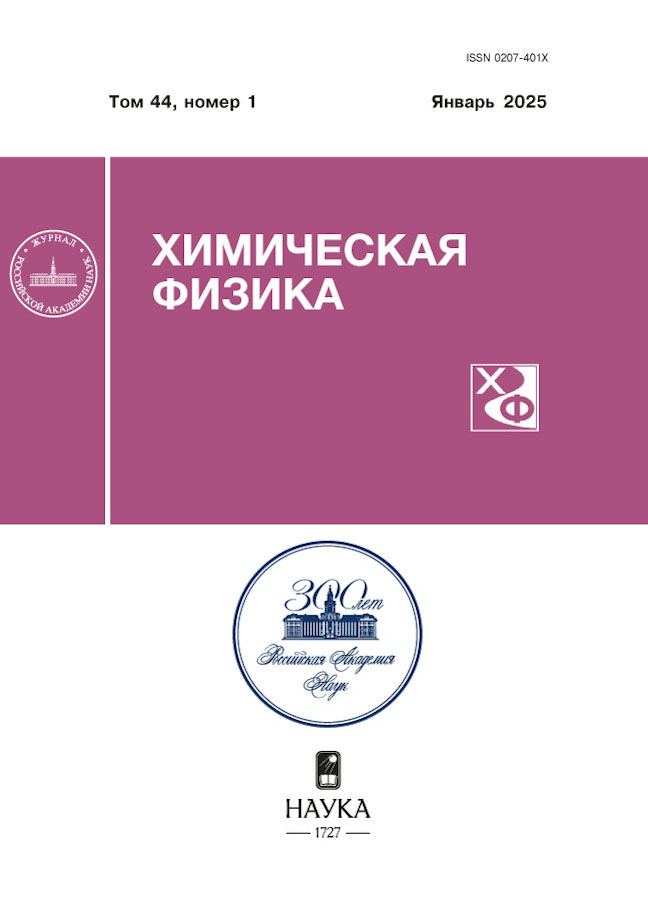Kinetics of the reaction of hydrogen evolution on steel in a hydrochloric acid solution containing corrosion inhibitors
- Autores: Avdeev Y.G.1, Nenasheva T.A.1, Luchkin A.Y.1, Panova A.V.1, Marshakov A.I.1, Kuznetsov Y.I.1
-
Afiliações:
- Frumkin Institute of Physical Chemistry and Electrochemistry, Russian Academy of Sciences
- Edição: Volume 44, Nº 1 (2025)
- Páginas: 26-35
- Seção: ВЛИЯНИЕ ВНЕШНИХ ФАКТОРОВ НА ФИЗИКО-ХИМИЧЕСКИЕ ПРЕВРАЩЕНИЯ
- URL: https://ter-arkhiv.ru/0207-401X/article/view/683319
- DOI: https://doi.org/10.31857/S0207401X25010033
- ID: 683319
Citar
Texto integral
Resumo
The kinetics of cathodic reduction of hydrogen on low-carbon steel in 2 M HCl (t = 25 °C) containing corrosion inhibitors – catamine AB and IFKhAN-92 – was studied. The main rate constants for the stages of hydrogen gas evolution and the introduction of hydrogen atoms into steel are determined. The additions of catamine AB and IFKhAN-92 inhibited the cathodic reduction of hydrogen and its permeation into steel in an HCl solution. The most effective inhibitor of hydrogen absorption is IFKhAN-92. The inhibitory effect of this compound is due to a decrease in the ratio of the hydrogen concentration in the metal phase to the degree of hydrogen filling of the surface. IFKhAN-92 reduction of hydrogen concentration in the volume of metal determines the preservation of the plastic properties of steels during corrosion in HCl solutions. The high efficiency of IFKhAN-92, as an inhibitor of cathodic reduction of hydrogen and its absorption, is the result of chemisorption of this compound on the surface of the steel and the formation of a polymolecular protective layer.
Texto integral
Sobre autores
Ya. Avdeev
Frumkin Institute of Physical Chemistry and Electrochemistry, Russian Academy of Sciences
Autor responsável pela correspondência
Email: avdeevavdeev@mail.ru
Rússia, Moscow
T. Nenasheva
Frumkin Institute of Physical Chemistry and Electrochemistry, Russian Academy of Sciences
Email: avdeevavdeev@mail.ru
Rússia, Moscow
A. Luchkin
Frumkin Institute of Physical Chemistry and Electrochemistry, Russian Academy of Sciences
Email: avdeevavdeev@mail.ru
Rússia, Moscow
A. Panova
Frumkin Institute of Physical Chemistry and Electrochemistry, Russian Academy of Sciences
Email: avdeevavdeev@mail.ru
Rússia, Moscow
A. Marshakov
Frumkin Institute of Physical Chemistry and Electrochemistry, Russian Academy of Sciences
Email: avdeevavdeev@mail.ru
Rússia, Moscow
Yu. Kuznetsov
Frumkin Institute of Physical Chemistry and Electrochemistry, Russian Academy of Sciences
Email: avdeevavdeev@mail.ru
Rússia, Moscow
Bibliografia
- Ya.G. Avdeev, T.A. Nenasheva, A.Yu. Luchkin et al. Russ. J. Phys. Chem. B, 18, 111 (2024). https://doi.org/10.1134/S1990793124010044
- E.I. Rudenko, N.V. Dohlikova, A.K. Gatin et al. Russ. J. Phys. Chem. B, 17(4), 845 (2023). https://doi.org/10.1134/S1990793123040164
- N.V. Dokhlikova, S.A. Ozerin, S.V. Doronin et al. Russ. J. Phys. Chem. B, 16(3), 461 (2022). https://doi.org/10.1134/S1990793122030137
- N.V. Dokhlikova, A.K. Gatin, S.Yu. Sarvadiy et al. Russ. J. Phys. Chem. B, 15(4), 732 (2021). https://doi.org/10.1134/S1990793121040023
- N.V. Dokhlikova, A.K. Gatin, S.Yu. Sarvadiy et al. Russ. J. Phys. Chem. B, 16(2), 361 (2022). https://doi.org/10.1134/S1990793122020166
- N.V. Dokhlikova, A.K. Gatin, S.Yu. Sarvadii et al. Russ. J. Phys. Chem. B, 14(5), 733 (2020). https://doi.org/10.1134/S1990793120050036 .
- S. Muralidharan, M.A. Quraishi and S.V.K. Iyer. Corros. Sci., 37, 1739 (1995). https://doi.org/10.1016/0010-938X(95)00068-U
- A.I. Marshakov, T.A. Nenasheva, A.A. Rybkina et al. Prot. Met., 43, 77 (2007). https://doi.org/10.1134/S0033173207010110
- S. Hari Kumar, P.A. Vivekanand, P. Kamaraj. Mat. Today: Proceed., 36, 898 (2021). https://doi.org/10.1016/j.matpr.2020.07.027
- M.A.V. Devanathan, Z. Stachurski. Proceeding of the royals Society. Ser. A. Mathematical and Physical Science, 270А, 90 (1962). https://doi.org/10.1098/rspa.1962.0205
- M.A.V. Devanathan, Z. Stachurski. J. Electrochem. Soc., 3, 619 (1964). https://doi.org/10.1149/1.2426195
- R.N. Iyer, H.W. Pickering, M. Zamanzadeh. J. Electrochem. Soc., 136, 2463 (1989). https://doi.org/10.1149/1.2097429
- B.N. Popov, J.-W. Lee, M.B. Djukic. Handbook of Environmental Degradation of Materials (Third Edition), Elsevier Inc., 133 (2018). https://doi.org/10.1016/B978-0-323-52472-8.00007-1
- C.D. Wagner, L.E. Davis, M.V. Zeller et al. Surf. Inter. Analysis., 3, 211 (1981). https://doi.org/10.1002/sia.740030506
- D.A. Shirley. Phys. Rev. B, 5, 4709 (1972). https://doi.org/10.1103/PhysRevB.5.4709
- T.J. Harvey, F.C. Walsh, A.H. Nahlé, J. Mol. Liq., 266, 160 (2018). https://doi.org/10.1016/j.molliq.2018.06.014
Arquivos suplementares

















